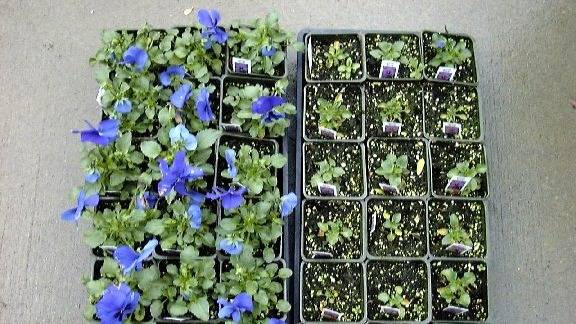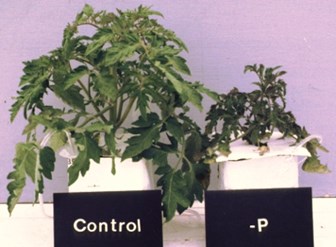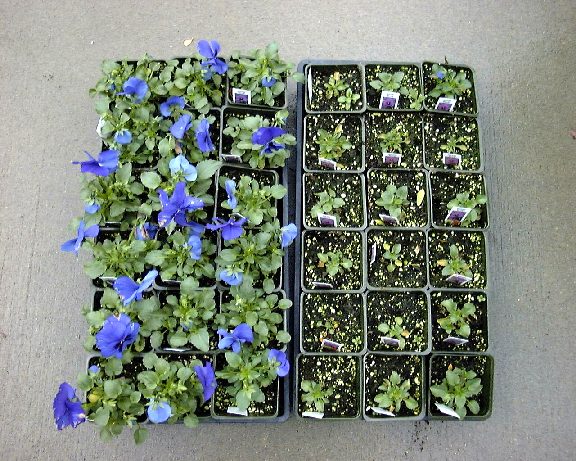Fertility Trends: Low Phosphorus Fertilization

The importance of phosphorus in horticulture has changed throughout the years. Before the use of soilless media, field soil was used to grow potted plants. Phosphorus application rates were high because phosphorus becomes immobile in soil as it easily binds to the cation exchange sites on soil particles and forms insoluble compounds with aluminum, calcium, magnesium and iron.
When soilless growing media were developed, this thinking came forward, but soilless media have a lower cation exchange capacity and very low levels of aluminum, calcium, magnesium and iron. Thus, for crops grown in soilless media, most of the applied phosphorus is available for plant uptake or is leached during irrigation.
Undesirable Effects
One benefit associated with an excessive application of phosphorus is increased flowering in plants. There is evidence to support this claim and therefore several fertilizers, including 5-40-17, 9-45-15, 10-30-20, etc., are available to help promote extra flowering. However, more recent research shows that excessive phosphorus applications (greater than 40 ppm P) cause undesirable stretching in plant stems.
Fertilizers with an equal or higher ratio of phosphorus (in the form of P2O5) to nitrogen induce stretching (e.g. 15-15-15, 20-20-20, etc.). Plants become too tall and spindly, leading to increased breakage and undesirable appearance.
Too Little Phosphorus?
Many growers have switched to lower phosphorus fertilizers such as 13-2-13, 17-5-17, 18-3-18, 20-3-19, etc., and some also use no phosphorus fertilizers such as 14-0-14 or 15-0-15. This will help reduce stretching and create more compact plants. However, phosphorus is still a required nutrient for plants. It is possible to reduce phosphorus application rates to a point that phosphorus deficiency can occur and plant health is compromised.
Figure 1 shows the effect of the absence of phosphorus on the growth of a tomato plant (right) compared to another tomato plant with normal levels of phosphorus (left)."
Figure 2 shows almost the same effect. The flat of pansies on the right did not have phosphorus incorporated into the starter fertilizer charge whereas the flat on the left did."
Both Figures 1 and 2 show that if a plant does not receive any phosphorus, it will restrict plant growth, but to the point that plants do not grow. The pansies without phosphorus seen in Figure 2 are much further behind schedule and of inferior quality to those with normal levels of phosphorus. The bottom line is that a low to no phosphorus fertilizer program can be detrimental.


Monitoring Phosphorus Levels
Phosphorus levels in the growing medium should be 5-20 ppm P (12-47 ppm P2O5). To know how much phosphorus is provided by low-phosphorus, water-soluble fertilizers, see Table 1. Many low-phosphorus fertilizers provide sufficient phosphorus when applied at rates of at least 100 ppm nitrogen. However, if fertilizer application rates are lower or if fertilizer is applied infrequently, phosphorus deficiency could occur in a crop.
| Fertilizer | ppm Phosphorus (P) applied* per nitrogen application rate |
|||
| 50 ppm N | 100 ppm N | 200 ppm N | 300 ppm N | |
| 13-2-13 | 3.4 ppm | 6.7 ppm | 13.4 ppm | 20.2 ppm |
| 15-0-15 | 0 ppm | 0 ppm | 0 ppm | 0 ppm |
| 17-5-17 | 6.4 ppm | 12.9 ppm | 25.7 ppm | 38.6 ppm |
| 18-3-18 | 3.6 ppm | 7.3 ppm | 14.6 ppm | 21.8 ppm |
| 20-3-19 | 3.3 ppm | 6.6 ppm | 13.1 ppm | 19.7 ppm |
| 20-10-20 | 10.9 ppm | 21.9 ppm | 43.7 ppm | 65.6 ppm |
Fertilizing with a low phosphorus fertilizer has advantages, but it is possible to go too far and provide insufficient levels of phosphorus, which stops plant growth. When using low-phosphorus fertilizers, it is best to monitor the phosphorus levels in the growing medium and plant tissue to minimize deficiencies.